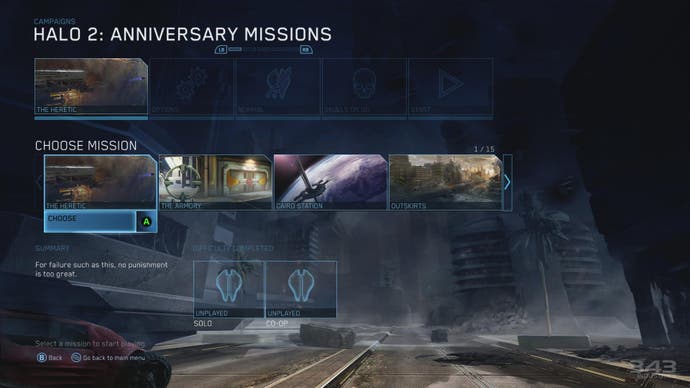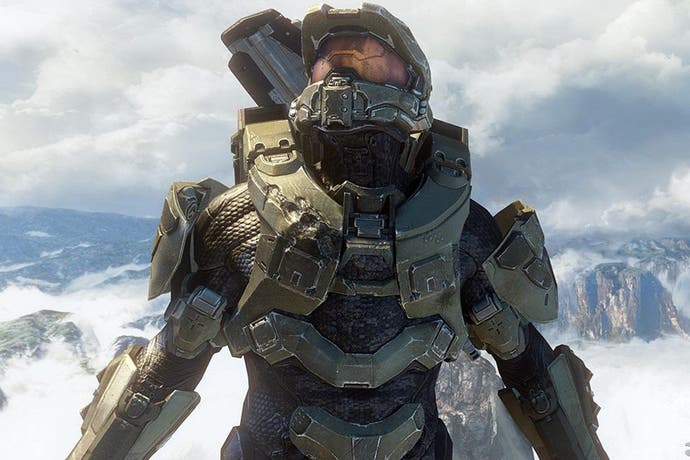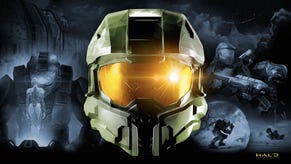Digital Foundry: Hands-on with Halo: The Master Chief Collection
UPDATE: New video and analysis added for each game in Microsoft's ambitious quad-title compilation.
UPDATE 5/11/14 17:15: Microsoft's Halo: The Master Chief Collection NDA has been adjusted, allowing us to show you more campaign video from each of the compilation's component games. We've got 60fps capture of each of the stages, and that includes a Halo 2 level that demonstrates the quality of the remaster.
Original story: It arrived earlier this week: an Xbox Live redeem code for one of the most ambitious remastering projects ever undertaken, offering four complete classic Halo titles brought across to Xbox One, spread across 44.5GB of data. Halo: The Master Chief Collection is in the house - the single-player elements final, with multiplayer and co-op currently being fixed up via that forthcoming 20GB Day One patch. With embargoes firmly in place and the multiplayer modes still being polished off as we write, what we can tell you about this fascinating package is limited but enlightening nonetheless.
While the single-player elements are fully-featured, final and complete, Microsoft's guidelines - put in place to ensure "the sense of rediscovery by fans" - limit us to showing you just one campaign level from each game, and in the case of the new anniversary edition of Halo 2, this turns out to be somewhat counter-productive. The Gravemind stage - with its limited, enclosed environments - does little to showcase one of the most anticipated elements of The Master Chief Collection: the ground-up remastering of this classic title, based on new assets designed with the power of Xbox One in mind. That will have to wait until the embargo lifts, when we will be looking more in-depth at the work of Saber Interactive and Certain Affinity.
However, the stages chosen for Halo: Combat Evolved, Halo 3 and Halo 4 offer up some interesting first impressions. The original Halo essentially takes the form of a direct conversion of the Xbox 360 Anniversary Edition, released in 2011. Innovative in many ways, a key component of the title was the ability to switch between the classic and remastered views at any point with just a single button-press. However, there were limitations in play - specifically an 1152x648 resolution plus a 30fps cap. Both of these restrictions are removed in the revised Anniversary Edition, which targets a full 1080p60 while retaining the retro 'switcheroo' feature.
Additional Analysis:
Based on a playthrough of the iconic Silent Cartographer stage, Saber's Xbox 360 artwork scales up nicely and comfortably into the full HD resolution, but the move to 60fps causes hiccups on two different fronts: internal simulation tick-rates for certain elements are hard-set by the original engine to a 30Hz refresh, producing scenes with some components - such as vehicles in the opening cut-scene, for instance - updating at a different rate to the renderer, resulting in obvious judder.
At other points, it's clear the engine itself can't sustain 60fps, introducing stutter of a different kind. Other elements of the scene - such as the obvious shadow cascade that sees some very noticeable pop-in - also remain unchanged from the Xbox 360 version. Look beyond the issues though, and what's fascinating is just how well the basics hold up even in the modern era. Halo: Combat Evolved may lack the refinements found in each subsequent sequel, but the gameplay here is still golden - Bungie got the fundamentals so right, and despite some of the rendering glitches, 60fps works here, elevating the experience.
Our experiences of the work carried out by Saber on Halo 2 are fairly limited based on the single level we have to go on - and that's a bit of a shame because there's so much more to get excited about than we can actually tell you at this point. However, the 30Hz elements of Halo 1 are gone, overall frame-rates are smoother, and the remastering work generally is on another level, but that will have to wait for now.
The only tangible compromise in the new Halo 2 concerns resolution - Saber settles on a 1328x1080 framebuffer, which produces rather interesting results. Upscaling artefacts are limited to the horizontal axis only, and the upscaling filter to make up the difference is pretty good. Since supporting the classic 'insta-switch' is apparently a key component in the resolution reduction, we would still have preferred this to have been an optional mode - with removing it restoring full 1080p - but as it happens, perhaps other developers might want to look at the results of a similar horizontal upscale in favour of the 900p 'default' we see in many multi-platform titles. Treyarch did something similar in Call of Duty: Black Ops 2 on Xbox 360, upscaling from 880x720, and the results were pretty good there too, though the benefits of full multi-sampling anti-aliasing were definitely a key component in that effect working.
One small technical element we did enjoy in Halo 2 comes from the cut-scenes - full-blown, brand new CG video in the remaster. Pressing the switch button instantly takes you back to the engine-driven 3D of the original game. Proof positive - if any were needed at this point - that Saber is indeed operating two complete game engines simultaneously.
The second brace of Halo titles in The Master Chief Collection sees a transition in both developer and design ethos. UK-based Ruffian Games takes on coding duties here, and what's immediately apparent is that these are direct conversions - essentially 1080p60 ports of the original games, with little in the way of actual 'remastering'. No moves are made in updating these games for the Xbox One generation over and above pixel-count and refresh rate, but for the purist this is actually a good thing.
Based on the Sierra 117 level we can show you at this point, Halo 3 is the surprise package. While it takes a while to get used to the angular, low-poly models, the sheer quality and style of Bungie's original art shines through and is presented without compromise: the sub-HD 1152x640 framebuffer(s) of the Xbox 360 original simply can't compare to the pristine 1080p offered by the new game. In addition to that, the anti-aliasing technique works beautifully in smoothing off the distracting upscaled jaggies of the original.
Frame-rate, too, is pretty consistent, sticking closely (but not perfectly) to the target 60Hz refresh. This is actually a double win - not only do we benefit from a 2x boost to temporal resolution, but it also sees the elimination of the odd frame-pacing issues seen in the original game. Both of these elements see the extra power offered by the Xbox One technology providing a tangible boost to gameplay - the raw playability of the experience is almost on another level compared to the original game. It's early days, of course, but we'd love to file Halo 3 alongside Bluepoint Studios' work on Metal Gear and God of War as a game where the quality of the original graphics and gameplay attain a new level running on more powerful hardware.
Additional Analysis:
Halo 4, the debut offering from 343 Industries, was the game we were looking forward to most in The Master Chief Collection, and the transition to Xbox One yields interesting results. For our money, the original is still the most technologically impressive title available on Xbox 360, and who wouldn't want to play this game at 1080p at 60fps? The preview level we can talk about right now - Infinity - is a decent slice of gameplay, covering off jungle terrain and vehicular combat, showcasing how well the stunning lighting, detailed environments and excellent effects-work scale up with a 2.25x boost to resolution and twice the frame-rate.
However, what's clear is that there's not quite the same revelatory boost to the quality of the visual presentation that there is with Halo 3. The original Halo 4 ran at 720p, not the sub-HD compromise of its predecessor, while anti-aliasing was taken care of fairly well with a post-process solution. Halo 3 had no anti-aliasing technology in place at all, and even before boosting frame-rate, Ruffian had plenty of scope for image quality improvements.
Our first impressions of Halo 4 are of refinement - everything is sharper and smoother - but the reality is that there were fewer issues hanging over from the last generation in need of redressing. In its new 1080p60 guise, Halo 4 is both a celebration of 343's accomplishments (we'd almost forgotten how good the performance capture and facial rendering was) but also an example of the remastering uncanny valley we also saw in The Last of Us on PS4. When it looks good, it's simply stunning, but lower quality assets - mostly ground textures in the Infinity stage - do stand out as incongruous, particularly when texture filtering doesn't show quite the improvement we would hope for.
Additional Analysis:
Another aspect shared with The Last of Us is a more inconsistent frame-rate, certainly in comparison with the more solid Halo 3. When we hit the magic 60, the experience is phenomenal, but the dips beneath are quite noticeable, and briefly interfere with the interface between player and machine in terms of controller response. Based on the context in which the dips are happening, it looks like Halo 4 may well be more CPU-limited than GPU - a reminder of just how capable the last-gen consoles were in that regard, particularly in the latter years when developers really pushed the older hardware to its limits. On the whole though, it's difficult not to be enthused by an Xbox One version of Halo 4. Looking back to our original coverage of the Xbox 360 version, we're reminded of just how beautiful this game was - and is. Even a 1080p port should be something very, very special.
Coming away from our preview session with The Master Chief Collection, we were left somewhat awed by the scale of ambition that 343 has injected into this project. It could have concentrated exclusively on the Halo 2 anniversary and left things at that. We're sure it would have been a commercial success, but it would not have been anything like as special as The Master Chief Collection. There is perhaps the sense that by going "all-in" like this, 343 Industries and its collaborators may have been spread a little too thin and that maybe each title should have had a similar focus to that enjoyed by Halo 2 - or even just a little more development time and effort.
For example, could Halo 1's performance wobbles have been resolved if Saber had more time to work on it, and if the studio wasn't producing Halo 2 at the same time? What if Ruffian was given time to replace the lower resolution assets in Halo 4, and had longer to optimise and refine performance?

In a sense, 343 is in a no-win situation - four games in one pack is a grand statement, comprehensively addressing the value arguments often levelled at current-gen remasters, but at the same time it means there's 4x the level of scrutiny on the project. There's a level of fan investment so high here that everyone - just like us - doubtless has their own views on the direction 343 should have taken and the choices that should or should not have been made.
But beyond those discussions and the countless "what ifs", it's clear from our preview of The Master Chief Collection that the scale of the achievement here is considerable. Unprecedented, even. We can boot up our Xbox One and an excellent, easy-to-use interface gives us quick and easy access to the entirety of the Master Chief story: every game, every level, every options combination - with single-player, co-op and multiplayer game variations all intact. And on top of that, there's the small matter of the remastered Halo 2 multiplayer component too, plus the promise of the Halo 5 beta next month. There's a huge story here where we've only just begun to scratch the surface, and we're looking forward to sharing more.












